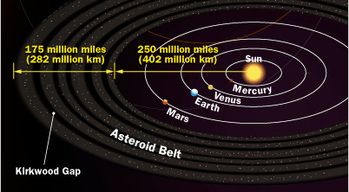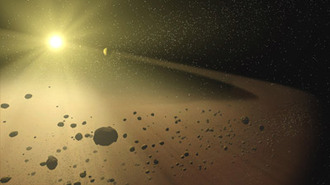Our Solar System
Asteroid Belt

Though too small to earn the distinction of planet, asteroids and comets strike huge fear in the human mind. And for good reason: at some point in the future, one of the chunky rocks or icy mud balls will slam into Earth and alter the course of history. Such an impact 65 million years ago is widely believed to have killed off the dinosaurs.
Asteroids are essentially chunks of rock that measure in size from a few feet to several miles in diameter. (Small asteroids are called meteoroids.) The largest asteroid, Ceres, is about 590 miles (950 kilometers) wide. Like most asteroids, it lies in the asteroid belt between Mars and Jupiter. Many astronomers believe the belt is primordial material that never glommed into a planet because of Jupiter's gravitational pull. Other astronomers say the belt is a planet that was broken apart during a collision.
Occasional collisions and gravitational tugs send asteroids careering toward the sun on highly elliptical orbits, some close enough to Earth to pose a risk of impact. Astronomers are constantly on the lookout for bodies on such a catastrophic trajectory. Most asteroids, fortunately, are too small to cause any damage. Instead they burn up in the atmosphere and appear to us as a shooting star.
Asteroids are essentially chunks of rock that measure in size from a few feet to several miles in diameter. (Small asteroids are called meteoroids.) The largest asteroid, Ceres, is about 590 miles (950 kilometers) wide. Like most asteroids, it lies in the asteroid belt between Mars and Jupiter. Many astronomers believe the belt is primordial material that never glommed into a planet because of Jupiter's gravitational pull. Other astronomers say the belt is a planet that was broken apart during a collision.
Occasional collisions and gravitational tugs send asteroids careering toward the sun on highly elliptical orbits, some close enough to Earth to pose a risk of impact. Astronomers are constantly on the lookout for bodies on such a catastrophic trajectory. Most asteroids, fortunately, are too small to cause any damage. Instead they burn up in the atmosphere and appear to us as a shooting star.
The Kirkwood Gaps

The gravitational force of Jupiter still affects the belt to this day -- its giant mass disturbs the path of asteroids and creates large gaps in the main belt known as Kirkwood gaps. This happens due to orbital resonance, which is the point when one body lines up with the orbit of another body and experiences a force. For example, an asteroid might make two full orbits around the sun in the time it takes Jupiter to make one orbit. Every other orbit, that asteroid would line up with Jupiter, and its orbit would experience a slight change. This causes several different groups of asteroids to cluster together, depending on how frequently they circle the sun -- it also leaves several gaps where there aren't any asteroids.
There are also two "clouds" of asteroids in front of and behind Jupiter's path, known as Jupiter Trojans, which act somewhat like bodyguards around the planet. Two similar groups are found along Mars's orbit called Martian Trojans.
There are also two "clouds" of asteroids in front of and behind Jupiter's path, known as Jupiter Trojans, which act somewhat like bodyguards around the planet. Two similar groups are found along Mars's orbit called Martian Trojans.
